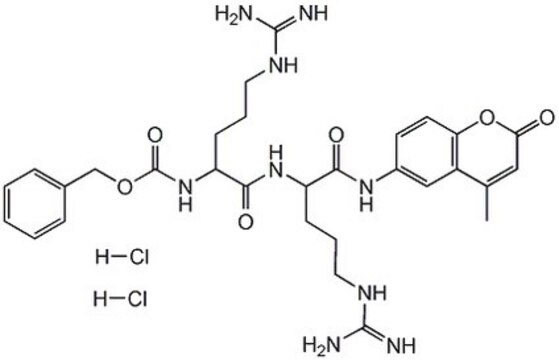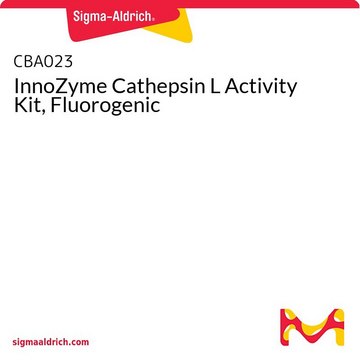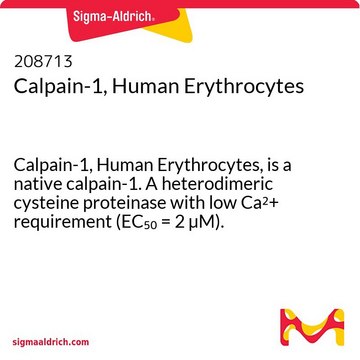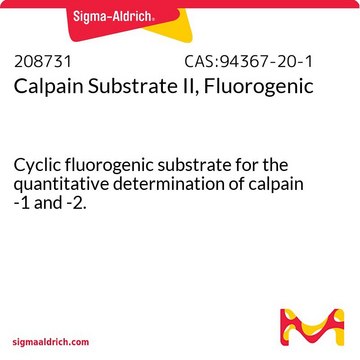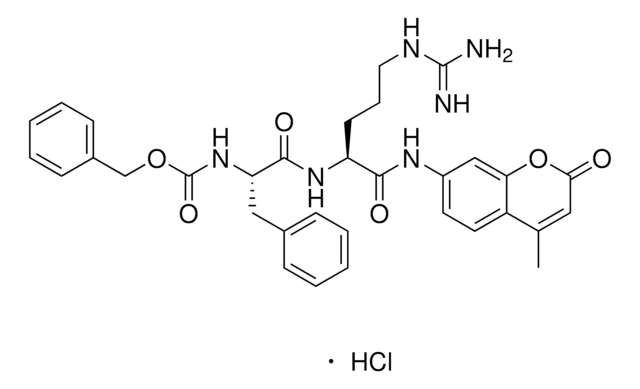Descripción general
A sensitive fluorogenic assay for the measurement of cathepsin B activity (Excitation max: ~360-380 nm; Emission max: ~430-460 nm). Cathepsin B is a cysteine proteinase which has been associated with increased invasivessness and development of the malignant cell phenotype. Cathepsin B has also been implicated in inflammatory airway disease.
Especificidad
<div class="Bio_doc_image">Table 3: Cross reactivity with others cathepsins
</div>
Componentes
Cathepsin B Enzyme, Calibration Standard, Cathepsin B Substrate, Assay Buffer, Cathepsin B Inhibitor, Reduction Reagent, Cell Lysis Buffer, Microtiter Plate, Plate Sealer, and a user protocol.
Advertencia
Toxicity: Multiple Toxicity Values, refer to MSDS (O)
Especificaciones
Assay Time: 30 min
Principio
The Calbiochem Cathepsin B Activity Assay Kit, Fluorogenic is designed to measure cathepsin B activity in tissues extracts and cell lysates, and for screening cathepsin B inhibitors.
Note: Following initial use the control Cathepsin B should be dispensed into aliquots and stored at -20°C. Avoid freeze/thaw cycles
Nota de preparación
• Dilution Buffer: dilute assay buffer 1:10 with dH2OExample: add 0.5 ml of assay buffer to 4.5 ml of distilled water. • Standard: the free AMC standard is supplied as a 2 mM stock (100-fold concentrated) solution. To create a calibration curve prepare serial dilutions of the standard ranging from a concentration of 20 µM to a concentration of 1.25 µM. Example: label 6 eppendorf tubes. Pipet 495 µl of the dilution buffer into the first tube and 250 µl into the remaining tubes. Add 5 µl of the 2 mM AMC standard to the first tube. Vortex and transfer 250 µl from this tube to the next tube. Continue serial dilutions by transferring 250 µl up to tube #5. The tube labeled #6 will contain dilution buffer only (blank).• Substrate Working Solution: substrate should be diluted 100 times with distilled water. Example: to prepare 2 ml of substrate solution add 20 µl of the substrate stock solution to 1.98 ml of distilled water. • Activation Buffer: cysteine is supplied as a 250-fold concentrated reagent. To prepare activation buffer 8 µl of 1 M cysteine should be added to 2 ml of the supplied assay buffer (this is enough for half of the plate). • Inhibitor: CA-074 inhibitor is supplied as a 10-fold stock solution and should be diluted with activation buffer. Example: dilute 10 µl of the stock solution with 90 µl of the activation buffer to yield 100 µl of working solution.• Control: dilute the control human cathepsin B with dilution buffer as directed on the vial label. The cathepsin B enzyme should be dispensed into aliquots and stored at -70°C to maintain activity.
Dilute samples with dilution buffer as necessary. Note: if the measured FU exceeds 9,000 the sample should be diluted further. • Cell lysate: wash cell pellet with ice-cold PBS. Add 500-1000 µl of cell lysis buffer (~1 ml per 1x107 cells) and incubate on ice for 30 min. Vortex and centrifuge the lysate at 14,000 x g in a pre-cooled tabletop microcentrifuge. Immediately transfer the supernatant to a fresh microcentrifuge tube and discard the pellet. Dilute the lysate 1:5 or 1:10 before determining the protein concentration via BCA protein assay.
Almacenamiento y estabilidad
Store the unopened components at -20°C and -70°C as indicated on the labels. All kit components, once opened, can be stored under the following conditions:
Assay Buffer, Cell Lysis Buffer, 96-Well Plate, and Plate Sealers at Room Temperature
Cathepsin B Inhibitor, Reduction Reagent, Cathepsin B Substrate, and Calibration Standard at -20°C
Control Cathepsin B(aliquot) at -70°C
Nota de análisis
Positive Control
Cathepsin B
The data obtained can be displayed in two ways:1. As fluorescence units: correct the fluorescence value of all samples by subtracting the value of the blank, and then calculate the mean fluorescence value for each sample in duplicate. For the biological samples also subtract the value of the sample assayed with inhibitor.OR2. As µmole of free AMC/mg total protein/time (min.): calculate the mean fluorescence value as stated above. Plot a graph correlating the mean fluorescence values of the AMC standards (y-axis) to their concentration in µmole (x-axis). The cathepsin B activity of the unknown samples can be interpolated from the standard curve.Calculate the amount (µmol) of free AMC per mg of total protein and time unit.
Otras notas
Bervar, A., et al. 2003. Biol. Chem. 384, 447.
Grigolo, B. et al. 2003. Biomaterials 24, 1751.
Scolaris, A., et al. 2002. Biol. Chem. 383, 1297.
Murata, M., et al. 1991. FEBS Lett. 280, 307.
Berquin, I.M. and Sloane, B.F. 1996. Adv. Exp. Med. Biol. 389, 281.
Burnett, D., 1995. Arch. Biochem. Biophys. 317, 305.
Reddy, V.Y., et al. 1995. Proc. Natl. Acad. Sci. 92, 3849.
Buttle, D.J., 1994. In: Immunopharmacology of Joints and Connective Tissue (Dingle, J.T. and Davies, M.E., eds) London: Academic Press. 225.
Barrett, A.J. and Kirschke, H., 1981. Methods Enzymol. 80, 535.
Información legal
CALBIOCHEM is a registered trademark of Merck KGaA, Darmstadt, Germany
